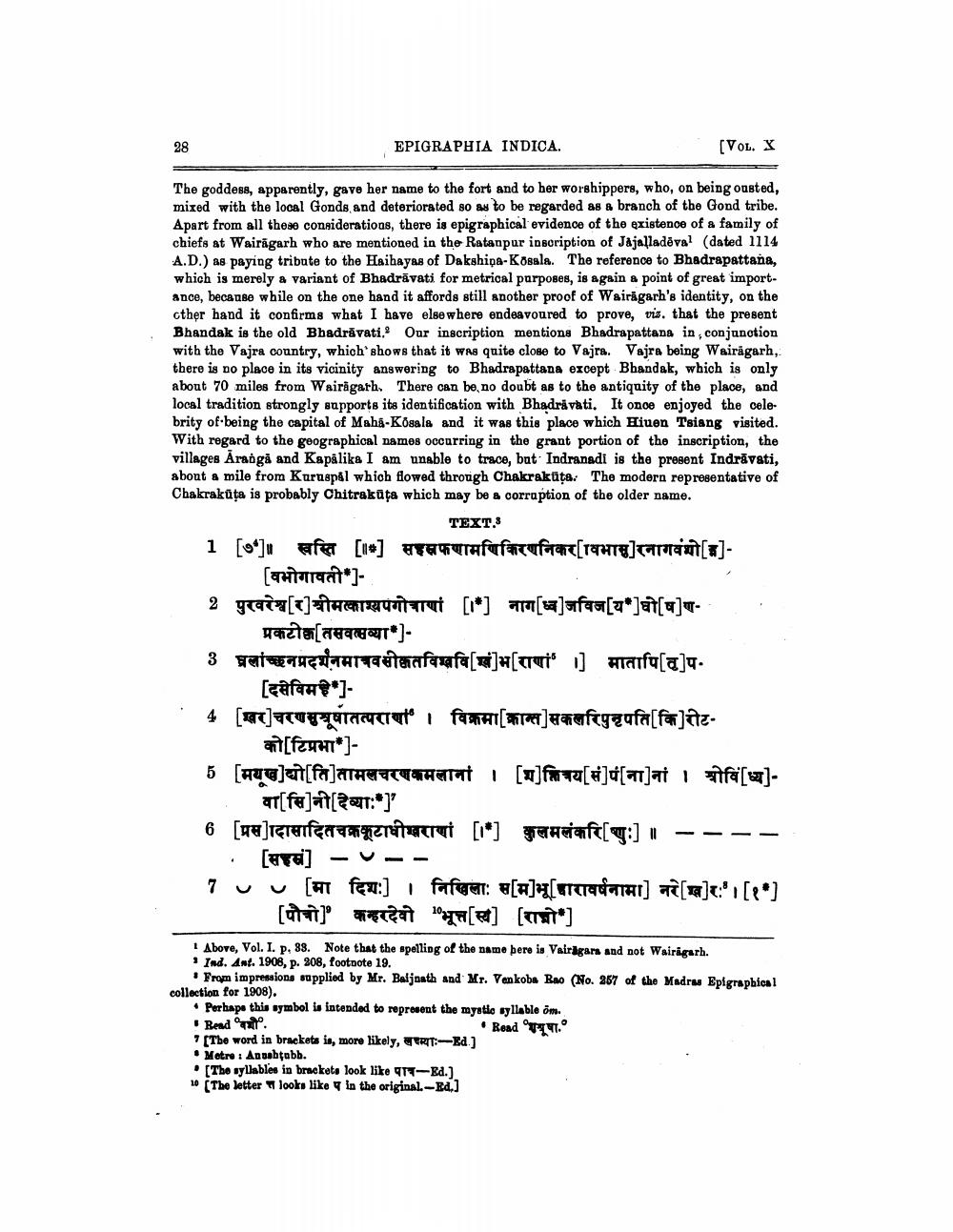________________
28
EPIGRAPHIA INDICA.
[VOL. X
The goddess, apparently, gave her name to the fort and to her worshippers, who, on being ousted, mixed with the local Gonds and deteriorated so as to be regarded as a branch of the Gond tribe. Apart from all these considerations, there is epigraphical evidence of the existence of a family of chiefs at Wairāgarh who are mentioned in the Ratanpur inscription of Jajalladeval (dated 1114 A.D.) as paying tribute to the Haihayas of Dakshipa-Kosala. The reference to Bhadrapattana, which is merely a variant of Bhadrāvati for metrical parposes, is again a point of great importance, becanbe while on the one hand it affords still another proof of Wairagarh's identity, on the other hand it confirms what I have elsewhere endeavoured to prove, vis. that the present Bhandak is the old Bhadrăvati. Our inscription mentions Bhadrapattana in, conjunction with the Vajra country, which shows that it was quite close to Vajra. Vajra being Wairagarh, there is no place in its vicinity answering to Bhadrapattana except Bhandak, which is only about 70 miles from Wairagarh. There can be no doubt as to the antiquity of the place, and local tradition strongly supports its identification with Bhadravati. It once enjoyed the cele brity of being the capital of Maha-Kósala and it was this place which Hiuen Tsiang visited. With regard to the geographical names occurring in the grant portion of the inscription, the villages Aranga and Kapalika I am unable to trace, bat Indranadi is the present Indrāvati, about a mile from Kuruspal which flowed through Chakrakaita. The modern representative of Chakrakūta is probably Chitrakūta which may be & corraption of the older name.
TEXT. 1 [*]॥ खस्ति [] सहस्रफणामणिकिरणनिकर विभा]रनागवंशो[] -
[वभोगावती*]2 पुरवरेश्वर]श्रीमत्काश्यपगोत्राणां [*] नाग[व]जविज[य*]घोषि]ण
प्रकटीक[तसवत्सव्या*]3 घलांच्छनप्रदर्शनमात्रवसीकृतविश्ववि[]भ[राणां' ।] मातापि[]प.
[दसेविमहे"]'4 [खरचरणसुश्रूषांतत्पराणा । विक्रमाक्रान्त सकलरिपुनृपति[किरीट
कोटिप्रभा*]5 [मयूख]द्यो[ति]तामसचरणकमलाना । [भ]लित्रय[सं][ना]नां । श्रीवि[ध्य]
वासिनी देव्याः*]' 6 [प्रस]ादासादितचक्रकूटाधीवराणां [*] कुलमलंकरि[ष्णुः] ॥ ----
. [सहसं] -~-- 7
[मा दिशः] । निखिला: म[मभू[चारावर्षनामा] नरे[व]रः । [१]
[पौत्रो कहरदेवो भूत्तस्य] [रात्रो"] Above, Vol. I. p. 38. Note that the spelling of the name bere is Vairagars and not Wairigarh. Ind. ant. 1908,P.208, footuote 19.
. From impressions supplied by Mr. Baijnath and Mr. Venkoba Bao (No. 267 of the Madras Epigraphical collection for 1908).
• Perhape this symbol is intended to represent the mystio syllable on. Read 'वौ.
___-Read एयूषा. 7 [The word in brackets in, more likely, RIT:-Ed.) • Motre : Anpabtabb. .[The syllables in brackets look like पाच-Ed.] 10 The letter looks like in the original-Ed.]




